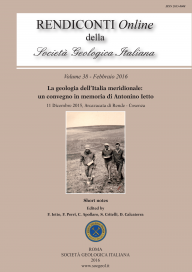
Plagioclase microstructures and compositions as tracers of mixing processes in weakly to strongly peraluminous granodiorites and granites from the Serre Batholith (southern Italy)
Patrizia Fiannacca (a), Rachele Lombardo (a), Gaia Maria Militello (a) & Rosolino Cirrincione (a)
(a) Department of Biological, Geological and Environmental Sciences , University of Catania, Corso Italia , 57, 95129, Catania, Italy. Corresponding author e-mail: pfianna@unict.it
Volume: 38/2016
Pages: 43-46
Abstract
The granitoids of the Serre Batholith make up the middle portion of an entire section of late Variscan continental crust exposed in the central Calabria. The most felsic rock types consist of two-mica K-feldspar megacrystic granodiorites and granites (BMPG), passing southward to two-mica granodiorites and granites (BMG), that grade further south to Bt±Am granodiorites (BAG). Microstructural features of plagioclase from the three granitoid units were studied in detail and An contents profiles were obtained for selected crystals from representative samples. Large (4-7 mm), medium (1-3 mm) and small (<1 mm) plagioclase grains were considered separately, in each granitoid group, based on the identification of distinctive microstructures. BMPG and most BMG are characterized by plagioclase with equilibrium microstructures and no or weak normal zoning suggesting an independent origin and an undisturbed crystallization in closed magmatic systems. Plagioclase from BMG proximal to BAG commonly displays disequilibrium features indicative of reaction with a more mafic magma, such as resorption surfaces, patchy zoning and especially reverse zoning with compositions approaching those of typical BAG. Finally, mixing with a further mafic magma appears to have locally occurred also in the BAG, as suggested by reverse zoning, with composition up to An71, in the intermediate portions of plagioclase from the MME-bearing samples.
Keywords
Get Full Text